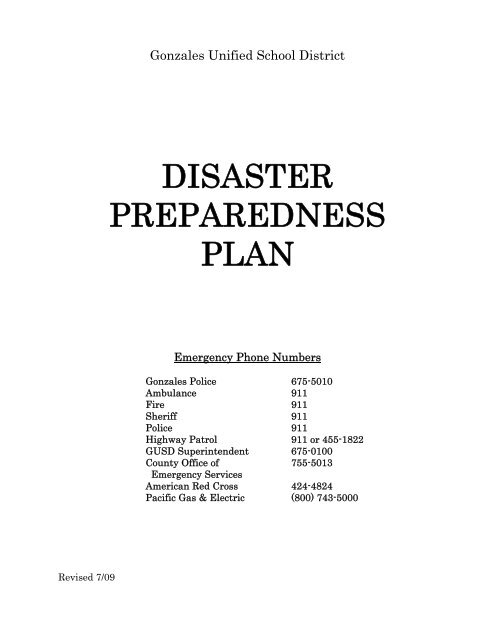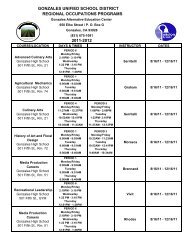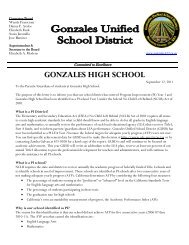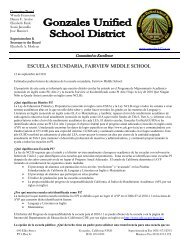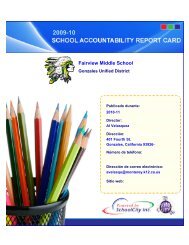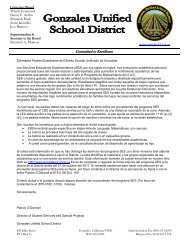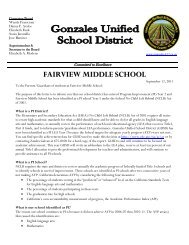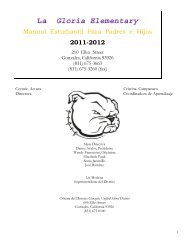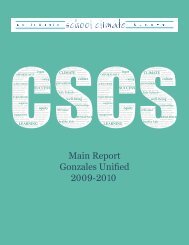DISASTER PREPAREDNESS PLAN - Gonzales Unified School District
DISASTER PREPAREDNESS PLAN - Gonzales Unified School District
DISASTER PREPAREDNESS PLAN - Gonzales Unified School District
Create successful ePaper yourself
Turn your PDF publications into a flip-book with our unique Google optimized e-Paper software.
<strong>Gonzales</strong> <strong>Unified</strong> <strong>School</strong> <strong>District</strong><br />
<strong>DISASTER</strong><br />
<strong>PREPAREDNESS</strong><br />
<strong>PLAN</strong><br />
Emergency Phone Numbers<br />
<strong>Gonzales</strong> Police 675-5010<br />
Ambulance 911<br />
Fire 911<br />
Sheriff 911<br />
Police 911<br />
Highway Patrol 911 or 455-1822<br />
GUSD Superintendent 675-0100<br />
County Office of 755-5013<br />
Emergency Services<br />
American Red Cross 424-4824<br />
Pacific Gas & Electric (800) 743-5000<br />
Revised 7/09
Table of Contents<br />
Activation of Emergency/Disaster Plan 1<br />
Purpose 1<br />
First Priority: Health and Safety of Students/Staff 1<br />
Second Priority: Notification of <strong>District</strong> Office 1<br />
Important Phone Numbers 1<br />
Personnel Duties and Responsibilities 2<br />
Superintendent Elizabeth A. Modena or designee 2<br />
Principal or designee 2<br />
Assistant Principal or designee 3<br />
Director of Support Services & Facilities or designee 4<br />
Principal's Secretary or designee 4<br />
Designated First Aid Personnel or designee 4<br />
Head Counselor or designee <strong>School</strong> Psychologist 4<br />
Teachers or designees 4<br />
Composition & Role of the Crisis Intervention Team 5<br />
<strong>School</strong> Site Crisis Intervention Team Members 5<br />
<strong>Gonzales</strong> High <strong>School</strong> 5<br />
Fairview Middle <strong>School</strong> 5<br />
La Gloria Elementary <strong>School</strong> 5<br />
Somavia High <strong>School</strong> (Continuation) 5<br />
State Preschool 5<br />
Activation of the Crisis Team/<strong>District</strong> Support Staff 5<br />
Site Facility & Equipment/Supply Information 6<br />
Equipment Supplies Checklist 6<br />
<strong>Gonzales</strong> High <strong>School</strong>/Alternative Education 6<br />
Fairview Middle <strong>School</strong> 6<br />
La Gloria Elementary <strong>School</strong>/Preschool 7<br />
<strong>School</strong> Map/Floor Plan 7<br />
Classroom Emergency Folders 7<br />
Purpose 7<br />
Contents to Include 8<br />
Communications Procedures 8<br />
<strong>School</strong> Site Communication Center 8<br />
Location 8<br />
Function 8<br />
Personnel 8<br />
Materials/Equipment 8<br />
Methods of Communication 9<br />
On-Site Communication Alternatives 9<br />
Off-Site Communcation 9<br />
Emergency Status Report Form 10<br />
Emergency Status Report Update Form 11<br />
Pupil Release/Evacuation Procedures 12<br />
Principal's Responsibilities 12<br />
Guidelines for Pupil Release in Classroom 12<br />
Classroom Release Procedures 12<br />
Identification Instructions 12<br />
Emergency Pupil Release Forms 14-17<br />
Guidelines for Release into Designated Large-Group Areas 18<br />
Evacuation Procedures 18<br />
Parent Notification/Responsibilities 19<br />
When to Inform 19<br />
What to Include in the Parent Notification 19<br />
Home Preparedness Suggestions 21
Emergency Action & Warning Signals 21<br />
Warning Signals 21<br />
Emergency Action 21<br />
Action Evacuation 21<br />
Action Go Home 22<br />
Action Convert Building 22<br />
Specific Emergecy/Disaster Procedures 22<br />
Bomb Threat 22<br />
Bomb Threat Checklist Form 23<br />
Bus Accident 24<br />
Going to <strong>School</strong> 24<br />
Going Home 24<br />
Campus Unrest 25<br />
Drive-By Shooting 25<br />
Earthquake 26<br />
Explosion 27<br />
Fallen Aircraft 27<br />
Flood 28<br />
Fire 29<br />
Hazardous Material 29<br />
Intruder/Hostage Situation 29<br />
Nuclear Emergency 30<br />
Strategic Warning of Nuclear Accident 30<br />
Attack Warning 30<br />
Nuclear Explosion 31<br />
Severe Windstorm 31<br />
Utility Outage 32<br />
Weapons on Campus 32<br />
Drill Procedures 33<br />
Student Drills 33<br />
Staff Drills/Review 33
ACTIVATION OF EMERGENCY/<strong>DISASTER</strong> <strong>PLAN</strong><br />
Purpose<br />
• To mobilize as soon as possible all site and community resources necessary to respond to the<br />
emergency disaster.<br />
First Priority: Health and Safety of Students/Staff<br />
1. Call 911 -- to activate the medical, fire, law enforcement, and emergency services<br />
2. Call Principal - <strong>Gonzales</strong> High <strong>School</strong> 675-2495, ext. 301<br />
Fairview Middle <strong>School</strong> 675-3704<br />
La Gloria Elementary <strong>School</strong> 675-3663<br />
Somavia Continuation High <strong>School</strong> 675-1081<br />
State Preschool 675-2519<br />
Second Priority: Notification of <strong>District</strong> Office(s)<br />
1. Call Superintendent (675-0100, ext. 110 or cell phone 917-2225)<br />
2. Call Assistant Superintendent of Business/HR (675-0100, ext. 105 or cell phone 595-6218)<br />
IMPORTANT PHONE NUMBERS<br />
<strong>Gonzales</strong> <strong>Unified</strong> <strong>School</strong> <strong>District</strong><br />
Superintendent 675-0100 ext. 110 or 917-0225<br />
Asst. Supt. of Business Office/HR 675-0100 ext. 105 or 595-6218<br />
Director of Special Proj/Student Services 675-0100 ext. 109 or 760-0103<br />
Director of Curriculum & Instruction 675-0100 ext. 115 or 596-9052<br />
Principals:<br />
<strong>Gonzales</strong> High <strong>School</strong> 675-2495 ext. 301 or (209) 620-7090<br />
La Gloria Elementary 675-3663 or 235-9743<br />
Fairview Middle 675-3704 or 901-5376<br />
Somavia Continuation High 675-1081 or 760-0103<br />
State Preschool 675-2519<br />
Assistant Principal/Learning Coordinators:<br />
<strong>Gonzales</strong> High <strong>School</strong> 675-2495 ext. 302 or 901-5360<br />
La Gloria Elementary 675-3663<br />
Fairview Middle 675-3704 or 578-4886<br />
<strong>Gonzales</strong> Police Department 675-5010<br />
Director of Support Services and Facilities 675-2495 ext. 380 / 675-2568 / 594-0606<br />
MOT Supervisor 675-2495 ext. 326 /675-2598 / 596-0419<br />
Monterey County Office of Education . . . . . . . . . . . . . . . . . . . 755-0301<br />
Office of Emergency Services . . . . . . . . . . . . . . . . . . . . . . . . . . . 755-5010<br />
American Red Cross . . . . . . . . . . . . . . . . . . . . . . . . . . . . . . . . . . . 424-4824<br />
California Highway Patrol . . . . . . . . . . . . . . . . . . . . . . . . . . . . . 911 or 455-4800<br />
Emergency Broadcast System . . . . . . . . . . . . . . . . . . . . . . . . . . . 755-5010<br />
*In case of emergency, turn your radio to KSCO 1080 AM<br />
Fire Department (Paramedics) . . . . . . . . . . . . . . . . . . . . . . . . . . . . . 911<br />
Pacific Gas & Electric . . . . . . . . . . . . . . . . . . . . . . . . . . . . . . . . . . . . . (800) 743-5000<br />
Salvation Army . . . . . . . . . . . . . . . . . . . . . . . . . . . . . . . . . . . . . . . . . . 424-0568<br />
Monterey County Sheriff . . . . . . . . . . . . . . . . . . . . . . . . . . . . . . . . . . 911 or 755-5111<br />
<strong>Gonzales</strong> Police Department . . . . . . . . . . . . . . . . . . . . . . . . . . . . . . 911 or 675-5010<br />
*Instructions on procedures for the public to follow in the case of an emergency or a disaster<br />
can be placed on the Emergency Broadcast System (KSCO) by contacting the Monterey County<br />
Office of Emergency Services.<br />
1
In the event of a major disaster, there is no guarantee that emergency medical or fire personnel will be<br />
able to immediately respond to school sites. Therefore, the school staff must be prepared to ensure the<br />
care and safety of students during the first several hours after a major disaster without outside assistance.<br />
It is critical to determine who does what, where, and how -- before such a disaster occurs.<br />
The disaster plan must include assignments for:<br />
• First aid<br />
• Search-and-rescue<br />
• Communication Center<br />
• Student safety/security<br />
• Building safety/security (Utilities)<br />
• Pupil release procedures<br />
Among the many responsibilities of the individual school sites during an emergency or disaster are those<br />
listed below. For each position, list site-specific responsibilities as well as a designee or back-up person in<br />
the event the primary person is not available.<br />
PERSONNEL DUTIES and RESPONSIBILITIES<br />
Superintendent or designee:<br />
1. Establish communications with Monterey County Office of Education and the Monterey County<br />
Office of Emergency Services, as required.<br />
2. Ensure all site level plans and procedures are updated as required and that all staff is trained in the<br />
procedures.<br />
3. Ensure emergency practice drills are performed at Sites.<br />
4. Ensure site level responses to emergencies are adequate and performed in a timely manner.<br />
5. Provide overall leadership and guidance, as required.<br />
Principal or designee:<br />
1. Establish emergency procedures that include notifying Superintendent, local law enforcement<br />
agencies, the fire department, and medical assistance agencies as appropriate.<br />
2. Coordinate with Director of Support Services and Facilities and Facilities to review and update the<br />
site level plan annually, with particular attention to the unique characteristics of the site.<br />
3. Post and regularly update a checklist of available emergency equipment supplies and emergency<br />
telephone numbers.<br />
4. Plan alternate classroom evacuation routes if standard routes are obstructed.<br />
5. Establish a communications system consisting of the following elements:<br />
a) System of specific disaster warning signals that are well known to staff and students, to include<br />
both bell and voice signals.<br />
b) System for voice-to-voice communication to use with electricity (telephone system) and without<br />
electricity (battery-operated bullhorns, two-way radios).<br />
c) Alternate system for written communication with staff in the event voice-to-voice<br />
communication is not available.<br />
d) Designation of a telephone line and number to be used only by the principal (or authorized<br />
person) and the Superintendent.<br />
2
e) Establishment of a communication center in a location accessible to parents, interested<br />
community members, and media to handle inquiries, rumor control, and information in an<br />
orderly fashion.<br />
f) Designation of a spokesperson to advise the media and respond to questions and concerns. (The<br />
press should be handled by the designated spokesperson exclusively and permitted to approach<br />
staff or students only after it has been determined by <strong>District</strong> Office officials and/or the site<br />
spokesperson that such contact would not adversely affect staff or students.)<br />
g) Designation of a person for recording incident for documentation purposes.<br />
6. Ensure that teachers are trained in responsibilities during disaster, drill procedures, and the buddy<br />
system.<br />
7. Ensure that each classroom contains a current emergency folder, properly labeled and located in a<br />
prominent place. (See page 7)<br />
8. Assign the following duties to school staff:<br />
a) Patrol main entrance to direct emergency personnel, parents, <strong>District</strong> staff to appropriate<br />
areas, and to prohibit unauthorized persons from entering campus.<br />
b) Monitor/supervise halls and corridors and to maintain a safe and secure environment.<br />
c) Conduct search-and-rescue operations to systematically search every room and area to locate<br />
trapped/injured persons and to recover critical supplies and equipment.<br />
d) Establish/coordinate a communication center.<br />
e) Administer first aid.<br />
f) Work with emergency medical triage teams to identify injured students and staff and to<br />
record ambulance destination.<br />
g) Supervise pupil release procedures.<br />
h) Check building utility systems and appliances for damage and possible shut-off.<br />
i) Provide for fire control.<br />
9. Ensure that all key-staff members --him/herself included-- know where main utility shut-off valves<br />
are located.<br />
10. Maintain a current inventory of available food/water supplies, and to ensure access to all food<br />
storage areas in an emergency.<br />
11. Schedule various disaster drills and to review the disaster plan with staff, students, and parents.<br />
Assistant Principal/Learning Coordinator or designee:<br />
1. Search and rescue--conduct team; report emergency needs to the school's communication center;<br />
locate missing students and personnel.<br />
2. Student safety and evacuation -- patrol and monitor campus; check all evacuation routes for safety.<br />
3. Take direction from Principal; act as liaison between Principal and staff.<br />
3
Director of Support Services and Facilities or designee:<br />
1. To review and update the site level plan annually in coordination with Principal or designee, with<br />
particular attention to the unique characteristics of the site.<br />
2. Maintain tool inventory for emergency use.<br />
3. Utility systems and appliances -- check for damage; if necessary shut off main power.<br />
4. Direct emergency personnel and vehicles through gates.<br />
5. Seal off and indicate areas where hazardous materials have been spilled.<br />
Principal's Secretary or designee:<br />
1. Assist Principal in sounding emergency action signals.<br />
2. Ascertain location and safety of office staff.<br />
3. Establish and coordinate Communication Center.<br />
4. Keep school radio tuned to KSCO (1080 AM); monitor and disseminate pertinent information.<br />
Designated First Aid Personnel or designee:<br />
1. Administer first aid/CPR as necessary to students/staff<br />
2. Distribute first aid supplies as necessary.<br />
3. Work with emergency medical personnel.<br />
Head Counselor or designee <strong>School</strong> Psychologist:<br />
1. Provide crisis intervention and emotional support to staff, students, and parents.<br />
Teachers or designees:<br />
1. Respond, with students, to emergency warning signals.<br />
2. Immediately take student attendance; notify school Communication Center of missing/injured<br />
students; place red or green sign on classroom door to indicate Need Help! (red) or Okay (green).<br />
3. Administer first aid as necessary.<br />
4. Check with teaching "buddy."<br />
5. Carry Emergency Classroom Folder when evacuating room.<br />
6. Release students as per Pupil Release Procedures (see pages 12-19).<br />
7. Remain calm; supervise and ensure student safety at all times.<br />
4
COMPOSITION & ROLE OF THE CRISIS INTERVENTION TEAM<br />
The <strong>School</strong> Site Crisis Intervention Team is comprised of designated staff members and district support<br />
personnel who are able to assist with the identification, assessment and intervention of students and staff<br />
affected by a traumatic event such as a natural disaster, sudden death, suicide, bus accident, drive-by<br />
shooting, etc.<br />
<strong>School</strong> Site Crisis Intervention Team Members<br />
Position Name Work Phone Home Phone<br />
Superintendent Elizabeth A. Modena 675-0100, ext. 110 373-1062<br />
Asst. Supt. Business Services/HR Sara M. Perez 675-0100, ext. 105 751-8222<br />
Director of Special Proj/Student Serv Patrick O’Donnell 675-0100, ext. 109 656-9844<br />
Director Support Services & Facilities K. Duane Wolgamott 675-2568/675-0100 (831) 594-0606 (cell)<br />
<strong>Gonzales</strong> High <strong>School</strong><br />
Position Name Work Phone Home Phone<br />
Principal Thomas Brownell 675-2495, ext. 301 (209) 620-7090<br />
Asst. Principal Julius Purnsley 675-2495, ext. 302 393-0953<br />
Principal's Secretary Lollie Rodriguez 675-2495, ext. 303 675-2193<br />
Fairview Middle <strong>School</strong><br />
Position Name Work Phone Home Number<br />
Principal Al Velasquez 675-3704 443-6113<br />
Learning Coordinator Jesus Velasquez 675-3704 757-5665<br />
Principal's Secretary Lupe Padilla 675-3781/675-3704 675-1180<br />
La Gloria Elementary <strong>School</strong><br />
Position Name Work Phone Home Number<br />
Principal Matthew Fleming 675-3663 (805) 472-2645<br />
Learning Coordinator TBA 675-3663<br />
Principal's Secretary Lupe Kinnear 675-3663 675-2713<br />
Secretary Gabriela Lopez 675-3663 759-2524<br />
Somavia High <strong>School</strong> (Continuation)<br />
Position Name Work Phone Home Number<br />
Principal Patrick O’Donnell 675-1081 656-9844<br />
Secretary Veronica Ramirez 675-1081 678-4118<br />
State Preschool<br />
Position Name Work Phone Home Number<br />
Lead Teacher/Site Supervisor Neyfy Fernandez 675-2519 675-1235<br />
Activation of the Crisis Team and <strong>District</strong> Support Staff<br />
In response to notification of an emergency or disaster, sudden death, suicide, school bus accident, etc.,<br />
the site administrator should immediately notify the Superintendent and immediate supervisor and<br />
assemble the Crisis Intervention Team to help plan the response and prepare for the following day. Plans<br />
should include:<br />
• Requesting assistance from the Public Information Officer to prepare a written statement and to<br />
direct other staff as to how to handle phone calls and requests for information about the<br />
emergency or disaster.<br />
5
• Establishing a crisis center on campus where crisis team members will be available to meet with<br />
students.<br />
• Notifying the Director of Student Services & Special Projects to secure additional assistance and<br />
to mobilize the <strong>District</strong> Crisis Team.<br />
• Promptly sharing factual information with staff, students, parents, and community.<br />
• Planning staff meetings or other communications as soon as possible to share information.<br />
• Providing an opportunity for teachers to meet with a designated crisis team member to obtain<br />
additional information on how to facilitate classroom discussion and to respond to students'<br />
questions and needs.<br />
• Providing a written statement which teachers may use to announce the event to students.<br />
• Requesting teachers to refer students who seem especially upset to the school's crisis center for<br />
individual counseling.<br />
SITE FACILITY & EQUIPMENT/SUPPLY INFORMATION<br />
Equipment/Supplies Checklist<br />
<strong>Gonzales</strong> High <strong>School</strong> / Alternative Education<br />
Office/Room Specific location<br />
Classroom Emergency Folders In all classrooms Next to door<br />
Disaster Plan In all classrooms Teacher Handbook<br />
Map/Floor Plan In all classrooms Emergency Folders<br />
Student Rosters In all classrooms Emergency Folders<br />
Student Emergency Cards In Main Office Principal’s Secretary<br />
Staff Roster & Room Assignments In Main Office Principal’s Secretary<br />
First Aid Supplies Main Office Nurse’s Office<br />
First Aid Supplies Each Classroom Disaster Bag<br />
Blankets<br />
Main Office<br />
Battery-Operated Radio<br />
Main Office<br />
Extra Batteries<br />
Warehouse<br />
Two-way Radios<br />
Main Office<br />
Flashlights/Batteries<br />
Main Office<br />
Tools (crowbars, wrenches, etc.) Maintenance Dept. Shop<br />
Soap/Restroom Supplies<br />
Warehouse<br />
Food/Water Supplies<br />
Cafeteria<br />
Extra Keys Main Office Principal’s Secretary<br />
Fairview Middle <strong>School</strong><br />
Office/Room Specific location<br />
Classroom Emergency Folders In all classrooms Next to door<br />
Disaster Plan In all classrooms Teacher Handbook<br />
<strong>School</strong> Map/Floor Plan In all classrooms Emergency Folder<br />
Student Rosters In all classrooms Emergency Folder<br />
Student Emergency Cards Main Office Principal’s Secretary<br />
Staff Roster & Room Assignments Main Office Principal’s Secretary<br />
First Aid Supplies Main Office Nurse’s Office<br />
First Aid Supplies Each Classroom Disaster Bag<br />
Blankets<br />
Main Office<br />
Battery-Operated Radio<br />
Main Office<br />
Extra Batteries<br />
Warehouse<br />
Two-way Radios<br />
Main Office<br />
Flashlights/Batteries<br />
Main Office<br />
Tools (crowbars, wrenches, etc.) Maintenance Dept. Shop<br />
6
Soap/Restroom Supplies<br />
Warehouse<br />
Food/Water Supplies Cafeteria GHS & La Gloria<br />
Extra Keys Main Office Principal’s Secretary<br />
La Gloria Elementary <strong>School</strong> / Preschool<br />
Office/Room<br />
Specific location<br />
Classroom Emergency Folders In all classrooms Next to door<br />
Disaster Plan In all classrooms Teacher Handbook<br />
<strong>School</strong> Map/Floor Plan In all classrooms Emergency Folder<br />
Student Rosters In all classrooms Emergency Folder Student<br />
Emergency Cards Main Office Principal’s Secretary<br />
Staff Roster & Room Assignments Main Office Principal's Secretary<br />
First Aid Supplies Main Office Nurse’s Office<br />
First Aid Supplies Each classroom Disaster Bag<br />
Blankets<br />
Main Office<br />
Battery-Operated Radio<br />
Main Office<br />
Extra Batteries<br />
Warehouse<br />
Two-way Radios<br />
Main Office<br />
Flashlights/Batteries<br />
Main Office<br />
Tools (crowbars, wrenches, etc.) Maintenance Dept. Shop<br />
Soap/Restroom Supplies<br />
Warehouse<br />
Food/Water Supplies<br />
Cafeteria<br />
Extra Keys Main Office Principal’s Secretary<br />
SCHOOL MAP / FLOOR <strong>PLAN</strong><br />
The school map/floor plan should be clearly marked with the following:<br />
1. Classrooms, library, first aid stations, multipurpose rooms, cafeteria, locker rooms, restrooms,<br />
hallways, doors<br />
2. Main shut-off valves for gas, water, electricity<br />
3. Fire extinguishers<br />
4. First aid kits<br />
5. Outside water faucets/hoses<br />
6. Evacuation routes (including alternate routes for each area*)<br />
7. Designated outside assembly areas*<br />
8. Emergency Supplies<br />
*Before determining large-group assembly areas and evacuation routes, each site administrator should<br />
request an on-site meeting with Facilities Services personnel to identify potential hazards which may<br />
occur during a major earthquake.<br />
CLASSROOM EMERGENCY FOLDERS<br />
The Principal will ensure that each classroom has a Classroom Emergency Folder appropriately labeled<br />
and located in a prominent place near the door.<br />
Purpose:<br />
To provide emergency information and materials for the regular classroom teacher, substitutes, and other<br />
<strong>District</strong> staff to ensure the identification and safety of students, and to facilitate appropriate pupil release<br />
procedures.<br />
7
Contents to include:<br />
1. Fire evacuation route map<br />
2. <strong>School</strong> map/floor plan<br />
3. Designated large-group assembly areas<br />
4. Emergency action signals, and procedures to follow for each<br />
5. Pupil Release Forms<br />
6. Name tags (self-stick) for each student in class (elementary only)<br />
7. RED and GREEN door signs to be posted on outside of door:<br />
a. RED - Needs help! Students and/or staff are injured<br />
b. GREEN- Okay! No additional help needed<br />
8. Current student roster/form (elementary) or Attendance roster (secondary)<br />
COMMUNICATIONS PROCEDURES<br />
<strong>School</strong> Site Communication Center<br />
Location<br />
• The Principal will designate a centrally-located area (usually Main Office) easily identified by staff,<br />
parents, media, and other persons.<br />
• An alternate location will be predetermined, in case the primary location is inaccessible.<br />
Function<br />
• Monitoring/disseminating pertinent emergency information (from Radio KSCO, 1080 AM).<br />
• Establishing communication with school staff.<br />
• Maintaining telephone/radio communication with <strong>District</strong> Office and emergency services.<br />
• Posting school maps to assist parents.<br />
• Posting rumor control/information in area accessible to parents, media, and members of the<br />
community.<br />
• Maintaining injury list and information regarding relocation to hospitals.<br />
• Providing pupil release clearances.<br />
• Recording emergency-related incidents if possible.<br />
• Maintaining communication with staff by whatever means available (bell warning system, intercom,<br />
bullhorn, two-way radio, written notices).<br />
• Carrying out other needed duties as needed.<br />
Personnel<br />
• Principal will assign staff, usually the Principal's Secretary and two to three assistants, to coordinate<br />
and operate the Communication Center.<br />
Materials/Equipment<br />
• Disaster Plan<br />
• Student rosters or attendance sheets<br />
• Emergency cards, Student Data cards/sheets with emergency pupil information<br />
• Pupil Release Clearance cards<br />
• Office equipment such as tables, chairs, phones, battery-operated radio, two-way radio, bullhorn,<br />
copy machine, general office supplies<br />
8
METHODS OF COMMUNICATION<br />
Following a disaster, particularly an earthquake, all systems of communication that are dependent on<br />
electrical power or telephone lines may be partially or totally disrupted for several hours. An effective<br />
communication plan addresses this problem and presents alternate ways to receive/convey messages.<br />
On-Site Communication Alternatives<br />
• Bell warning system<br />
• Intercom<br />
• P.A. system<br />
• Written notices<br />
• Signaling devices such as whistles<br />
• Two-way radios<br />
• Battery-operated radio<br />
Off-Site Communication<br />
• Telephones<br />
• Two-way radios in <strong>District</strong> vehicles (buses, police cars, etc.)<br />
• Principal's emergency phone line<br />
• Cellular phones<br />
Each telephone/radio communication should be brief and concise in order to enable <strong>District</strong> or<br />
emergency personnel to complete their survey of the school(s) as quickly as possible. Their need is to<br />
assess conditions at all schools, determine priorities, and send help where it is most urgently needed.<br />
(See Emergency Status Report, page 10.)<br />
Given the level of damage generated by a disaster, the telephone lines may be partially or totally<br />
disrupted. Disruption of circuits may also be caused by overloading circuits.<br />
Do not contribute to system overload. During the first two hours of a major disaster, use telephone lines<br />
only to report life-threatening emergencies.<br />
9
EMERGENCY STATUS REPORT<br />
Date:<br />
Time:<br />
Reported to:<br />
Superintendent <strong>District</strong> Office<br />
Office of Emergency Services<br />
Police<br />
Immediate Assistance Required:<br />
Missing (number): Trapped in building (number): Injured (number):<br />
Number requiring immediate medical attention:<br />
• Attach lists of all missing, trapped, or injured persons.<br />
Condition of Staff and Students:<br />
All accounted for: staff (number) ________ students (number) ________<br />
No immediate help required:<br />
No injuries: ________<br />
Missing (number): Trapped in building (number): Injured (number)<br />
Number requiring immediate medical attention:<br />
• Attach lists of all missing, trapped, or injured persons.<br />
Condition of <strong>School</strong> Building and Grounds: (e.g. cracked walls, fallen light fixtures,<br />
shattered windows, broken water pipes, flooding, etc.)<br />
Condition of Surrounding Areas: (e.g. fallen power lines, debris-cluttered streets, etc.)<br />
10
EMERGENCY STATUS REPORT UPDATE<br />
Reported to:<br />
Date:<br />
Superintendent<br />
Time:<br />
Office of Emergency Services<br />
Police<br />
Number of children remaining at school:<br />
Number of staff members remaining to care for children:<br />
Assistance required: Water Food Blankets<br />
Additional personnel to assist in student care (number):<br />
Person completing this report:_________________________________________<br />
- - - - - - - - - - - - - - - - - - - - - - - - - - - - - - - - - - - - - - - - - - - - - - - - - - - - - - - - - - - - - - - - - - -<br />
EMERGENCY STATUS REPORT UPDATE<br />
Reported to:<br />
Date:<br />
Superintendent<br />
Time:<br />
Office of Emergency Services<br />
Police<br />
Number of children remaining at school:<br />
Number of staff members remaining to care for children:<br />
Assistance required: Water Food Blankets<br />
Additional personnel to assist in student care (number):<br />
Person completing this report:_________________________________________<br />
- - - - - - - - - - - - - - - - - - - - - - - - - - - - - - - - - - - - - - - - - - - - - - - - - - - - - - - - - - - - - - - - - - -<br />
EMERGENCY STATUS REPORT UPDATE<br />
Reported to:<br />
Date:<br />
Superintendent<br />
Time:<br />
Office of Emergency Services<br />
Police<br />
Number of children remaining at school:<br />
Number of staff members remaining to care for children:<br />
Assistance required: Water Food Blankets<br />
Additional personnel to assist in student care (number):<br />
Person completing this report:_________________________________________<br />
11
PUPIL RELEASE/EVACUATION PROCEDURES<br />
Certain actions may involve releasing students from school or relocating them from one school site to<br />
another at a time when parents expect their children to be in school. The Superintendent will authorize<br />
such actions only in times of extreme emergency, and all possible attempts to notify parents as to the<br />
situation will be made as soon as possible. In any case, only <strong>District</strong> staff will release pupils. Daily<br />
attendance is a critical component in preparing for any emergency or disaster.<br />
Principal's Responsibilities<br />
The principal will assess the situation in any given emergency and, based on the safety of students and<br />
the condition of the school and neighborhood, will make recommendations to the Superintendent.<br />
Alternatives include:<br />
1. Students remain in classrooms with their teachers until they are released to their parents or are<br />
transported home via regular bus routes and times.<br />
2. Students are moved with their teachers to designated large-group areas on the school site.<br />
3. Students will be evacuated to an alternate site.<br />
If an emergency occurs and it becomes necessary to send students home early, relocate them, or ask<br />
parents/guardians to pick them up, then these procedures will be followed insofar as possible.<br />
1. Notification of Parents - After receiving authorization to relocate students or send them<br />
home early, the school will initiate phone trees to notify parents of the situation, using all<br />
available phones. Information will include:<br />
• name of caller<br />
• type of emergency<br />
• action to be taken<br />
• where parent may pick up child<br />
• any other pertinent information (be brief)<br />
2. Notification of Staff - Teachers and other staff members should be notified of the plan as<br />
soon as possible.<br />
Whenever possible, it is preferred that students remain in their classrooms under their teacher's<br />
supervision.<br />
GUIDELINES FOR PUPIL RELEASE IN CLASSROOM<br />
Classroom Release Procedures<br />
1. Teacher stands at door, controlling traffic in and out.<br />
2. Parents line up outside door.<br />
3. Teacher identifies immediate family members using the Emergency Pupil Release Form found in<br />
the Classroom Emergency Folder.<br />
4. Teacher refers all other persons to the Communication Center to obtain Clearance Cards.<br />
5. Child leaves with parent. Parents should not enter classroom unless necessary.<br />
Identification Instructions<br />
1. Use Emergency Pupil Release Form located on the following pages and also in the Classroom<br />
Emergency Folder. Fill in all sections, including signatures. (Secondary teachers make notations<br />
on student attendance roster regarding the release of students.)<br />
2. Make sure it is an immediate family member.<br />
• Immediate family may include mother, father, stepmother, stepfather, grandparent(s), aunt,<br />
uncle, sister, brother, or legal guardian.<br />
12
Identification Instructions (continued)<br />
• Identification questions may include:<br />
‣ Who are you?<br />
‣ What is your relationship to this child?<br />
‣ Do you have a photo ID?<br />
‣ If necessary, ask the child who this person is.<br />
3. Refer all persons other than immediate family members or any person about whom the teacher<br />
has doubts to the Communication Center to obtain clearance cards.<br />
4. Keep all clearance cards and attach them to Pupil Release Forms.<br />
Note: These procedures are quite specific to ensure that younger students are released to authorized<br />
adults. The guidelines may be modified for the release of secondary students as long as pupils are<br />
released in a safe and authorized manner.<br />
13
GUIDELINES FOR RELEASE INTO DESIGNATED LARGE-GROUP AREAS<br />
Depending on the specific emergency, it may be necessary to relocate students from one or more<br />
classrooms to designated large-group areas. Guidelines for this are as follows:<br />
1. These areas should be designated in advance. On-site buildings (e.g. auditorium, cafeteria, gym,<br />
multipurpose room), nearby buildings (e.g. church), or outdoor fire drill areas may need to be<br />
utilized.<br />
2. Map of the designated large-group area is to be located in the Classroom Emergency Folder.<br />
3. Signs must be posted outside of classrooms to indicate location of students.<br />
4. Signs must be posted in designated large-group area to clearly identify teacher's name, grade,<br />
and room number.<br />
5. A plan must be developed to easily route parents to and from the designated large-group area so<br />
they can pick up their children.<br />
Upon notification, students and teachers will move to their designated large-group area together,<br />
following these procedures:<br />
1. Teacher posts sign on door to indicate where students have been relocated.<br />
2. Teacher posts a RED (Needs help!) or GREEN (Okay!) sign on the door.<br />
3. Teacher takes Classroom Emergency Folder.<br />
4. If there are injured students who are unable to move, teacher remains with them while the<br />
classroom aide or teacher's "buddy" moves the rest of the class to the large-group area.<br />
Teacher releases students from the large-group area following the same procedures as in classroom pupil<br />
release.<br />
EVACUATION PROCEDURES<br />
When students are evacuated from a school site to an alternate site, certain procedures must be observed<br />
to ensure that the whereabouts of all students is known at all times.<br />
• Using the student roster found in the Classroom Emergency Folder, teachers will check students<br />
onto buses, noting the bus number and the destination(s).<br />
• The student rosters (or copies) will be kept in the Communication Center so that parents may be<br />
notified as to the location of their children when they call.<br />
• Elementary students should be furnished with name tags which state their name, grade, school,<br />
and teacher's name.<br />
• Secondary teachers should, in the event of an evacuation, note in their roll books the names of<br />
students who plan on using school bus transportation as well as those who plan on using private<br />
transportation.<br />
Note: In any early dismissal operation, situations will probably arise which are not covered in this plan.<br />
In such cases, the principal will have to use his/her judgment as to the best course of action to follow.<br />
18
PARENT NOTIFICATION/RESPONSIBILITIES<br />
If parents are not aware of your emergency plans, they are likely to risk their own lives and impede the<br />
operation of your response plan to retrieve their children. A plan for communicating with parents before<br />
and after an emergency is critical. It may not eliminate the problem, but it will help to reduce congestion,<br />
confusion, and anxiety.<br />
If parents are not repeatedly made aware of your disaster plan, you can expect:<br />
• a flood of telephone calls (if system is working);<br />
• a major traffic jam in front of the school; and<br />
• unauthorized persons (neighbors, friends, etc.) volunteering to take students home.<br />
When to Inform<br />
At the beginning of each academic year, parents should be advised of the school's emergency plans. It is<br />
recommended that the procedures and rules you expect parents to follow should be firmly stated by way<br />
of:<br />
• the opening school letter to parents;<br />
• meetings of the Parent-Teachers Association, <strong>School</strong> Site Council, etc.;<br />
• the back-to-school-night meeting; and<br />
• the parent newsletter<br />
In addition, consider sending letters or commenting in the parent newsletter immediately after the<br />
occurrence of a significant disaster in the U.S. or other countries. You might start your letter with<br />
something like:<br />
"On _________, a damaging earthquake occurred in ________. We want to<br />
take this opportunity to remind you of our plan..."<br />
What to Include in the Parent Notification<br />
• The school's disaster plan has been designed for the safety of students. Parents have the<br />
responsibility to share in the planning, preparing, and carrying out of this plan in the event of an<br />
emergency.<br />
• We are prepared to care for your children in times of critical situations. If you are not able to<br />
reach the school, we will care for your child here. We have a number of people with first aid<br />
certificates, and we will be in communication with various local emergency services. We do ask<br />
for your help in the following areas:<br />
1. Please do not call the school. We must keep the lines open for emergencies.<br />
2. Following an earthquake or other emergency, do not immediately drive to the school. Streets<br />
and access to our school may be cluttered with debris. The school access route and street<br />
entrance areas must remain clear for emergency vehicles.<br />
3. Turn your radio to KSCO (1080 AM). Information and directions will be given over the<br />
radio.<br />
• No student will be dismissed from school unless parent (or individual designated by the parent)<br />
comes for him or her.<br />
• No child will be allowed to leave with another person, even a relative or baby-sitter, unless we<br />
have written permission to that effect or that particular person is listed on the student's emergency<br />
card in our files. With this in mind, you should make sure to keep your child's card up-to-date.<br />
• All parents or designated parties who come for students should bring a photo ID.<br />
• Drill procedures for emergencies and disasters will periodically be practiced at school.<br />
19
Home Preparedness Suggestions<br />
• Keep a supply of food that doesn't need cooking and jugs of drinking water in case of loss of<br />
power or evacuation emergencies.<br />
• Keep blankets, first aid kit, and flashlight ready.<br />
• Keep important papers, special medications, eyeglasses, etc., handy.<br />
• Keep a battery-operated radio handy with KSCO (1080 AM) marked on the dial.<br />
• Keep your car's gas tank at least half full in case of sudden evacuation.<br />
• Do not use your telephone during major disasters. Keep lines open for emergency messages.<br />
• Discuss personal survival plans with your family, i.e. where all family members meet, the name<br />
of your doctor, etc.<br />
• Discuss actions family members are to take in the event you are separated for a long period of<br />
time.<br />
• Discuss use of emergency 911 calls.<br />
• Be sure your children know how to contact you during the school day or who to contact if you<br />
are not at home. Parents without telephones need to designate an emergency contact person the<br />
school can reach.<br />
• Do hazard searches within the home looking for potential safety hazards in the event of an<br />
emergency.<br />
• Become familiar with the school's disaster plan so that you will be prepared to deal with an<br />
emergency.<br />
20
EMERGENCY ACTION & WARNING SIGNALS<br />
Warning Signals<br />
Emergency Action Bell Signal Voice Signal What to Do<br />
ALL CLEAR one long bell "All Clear" May return to<br />
building.<br />
LEAVE BUILDING fire alarm "leave building" Move students<br />
and staff, in<br />
an orderly<br />
fashion, to an<br />
outside area<br />
of safety.<br />
SECURE BUILDING one short bell "Secure Building" Lock all doors<br />
followed by<br />
and windows.<br />
one long bell -<br />
Pull shades.<br />
repeated 5 times<br />
Those in<br />
outside areas<br />
immediately<br />
return to class<br />
rooms.<br />
Warning Signals (continued)<br />
DUCK, COVER, three short "Duck, Cover Duck to knees<br />
HOLD bells followed Hold" underneath<br />
by one long -<br />
table or desk,<br />
repeated 5<br />
away from<br />
times<br />
windows, with<br />
both hands<br />
holding a desk<br />
or table leg.<br />
Emergency Action<br />
Action Evacuation<br />
This action, which is authorized by the Superintendent, consists of vacating a site and transporting<br />
students and staff to another predetermined location. Parent notification will be made by phone, public<br />
announcements, radio and television broadcasts, or other means to acquaint them with the location of the<br />
evacuation site. (See Pupil Release Procedures, page 12)<br />
Action Go Home<br />
This action, which is initiated by voice or written communication, consists of dismissing students from<br />
classes and returning them to their homes by the most expeditious means. This action will be authorized<br />
by the Superintendent only if there is time to transport students to their homes and, in case of early<br />
dismissal, only if time exists to notify parents or guardians that they will be arriving home early. (See<br />
Pupil Release Procedures, page 12)<br />
21
Action Convert Building<br />
This action is the process involved in preparing the school for conversion to a congregate care center, first<br />
aid station, or feeding center. (This would be done as part of the district's arrangement with other<br />
community agencies.)<br />
If appropriate, students will be sent home; if not, they will remain at school under the teacher's care and<br />
await further instructions. (Note: in any emergency situation where students have to move in groups<br />
from one class to another, it is recommended that the "buddy system" be used. This should be a<br />
mandatory part of any school plan. Teachers should also set up a buddy system among each other in the<br />
event of a severe disaster.)<br />
SPECIFIC EMERGENCY/<strong>DISASTER</strong> PROCEDURES<br />
BOMB THREAT<br />
Although bomb threats are not uncommon, there has never been an actual bomb discovered in a district<br />
building. Nevertheless, all such threats must be taken seriously.<br />
Responsibilities<br />
Principal 1) Notify the Superintendent, and, if it is deemed necessary,<br />
implement Action Leave Building.<br />
2) Notify <strong>Gonzales</strong> Police (675-5010) and appropriate law<br />
enforcement agencies and the fire department (911).<br />
3) In the event of a school evacuation, initiate a school search for<br />
the device. The search is to be conducted by law enforcement<br />
agencies with the help of appropriate school staff (e.g., site<br />
administrator and custodian).<br />
4) Keep students and staff out of all buildings until advised by law<br />
enforcement agencies and/or the fire department that it is safe<br />
to return.<br />
Staff 1) Remain calm and keep the bomb threat caller on the phone as<br />
long as possible.<br />
2) Complete as much of the Bomb Threat Check-list as possible.<br />
(next page)<br />
3) Immediately notify the principal or site administrator of the<br />
threat.<br />
22
<strong>Gonzales</strong> <strong>Unified</strong> <strong>School</strong> <strong>District</strong><br />
Bomb Threat Checklist<br />
(to be completed by person receiving bomb threat phone call)<br />
<strong>School</strong>: Staff member taking call: Time: Date:<br />
Listen carefully. Do not interrupt the caller except to ask:<br />
When will it go off?<br />
Where is it located?<br />
What does it look like?<br />
Does the caller appear familiar with the building? yes no<br />
Caller's Identity: Sex: Estimated age:<br />
Voice Characteristics:<br />
Speech:<br />
loud soft fast slow<br />
high-pitched deep distinct distorted<br />
raspy pleasant stutter nasal<br />
intoxicated other slurred other<br />
Language: Accent: Demeanor:<br />
educated local calm coherent<br />
fair foreign rational incoherent<br />
poor regional deliberate irrational<br />
foul race angry emotional<br />
use of certain other righteous laughing<br />
words/phrases<br />
Background Noises:<br />
office machines noisy street traffic voices<br />
factory machines quiet train(s) music<br />
animals mixed airplane(s) party<br />
atmosphere<br />
Immediately after the phone call:<br />
1. Notify your principal or site administrator. Talk to no one unless instructed to<br />
do so.<br />
2. Write the message in its entirety and attach to this checklist.<br />
23
BUS ACCIDENT<br />
Although there has never been a major bus accident at <strong>Gonzales</strong> <strong>Unified</strong> <strong>School</strong> <strong>District</strong>, accidents<br />
involving buses have occurred in which students have suffered minor injuries. If a bus accident occurs,<br />
these procedures will be followed:<br />
Going to <strong>School</strong><br />
Responsibilities<br />
Driver 1) Evaluate students for injuries.<br />
2) Notify Transportation Office of the situation (via two-way radio). The<br />
Transportation Office will notify CHP, paramedics (if necessary), school<br />
sites, the Superintendent, etc.<br />
3) Continue transporting students to school when so authorized by the<br />
CHP.<br />
Principal 1) Upon notification of the incident by the Transportation Office,<br />
immediately contact Health Services to obtain school nursing assistance.<br />
Going Home<br />
2) Secure the names of all the students on the bus when it arrives at school,<br />
and direct them to a specific location.<br />
3) With assistance from the school nurse, health clerk, or designated first<br />
aid person, determine whether there are any other injured students.<br />
4) Contact the parents of any injured students to inform them of the nature<br />
and extent of the injury.<br />
5) Send notices home with all students on the bus. Describe the incident;<br />
suggest that parents observe their children for any signs or symptoms of<br />
injury and obtain medical assistance if necessary.<br />
Responsibilities<br />
Driver 1) Follow the same procedures as those regarding accidents en route to<br />
school. In addition, take names and addresses of all students on the bus.<br />
Transportation 1) Notify home school of the situation. Deliver a list to the office of names<br />
of students who were on the bus.<br />
Principal 1) Upon notification of the accident, notify parents of injured students,<br />
including the whereabouts of those students taken by paramedics.<br />
2) The next day, send notices home with all students on the bus, describing<br />
the incident and suggesting that parents observe their<br />
youngsters for any signs or symptoms of injury. In the event of a bus<br />
accident in which serious injuries or fatalities occur, school district<br />
officials will operate at the direction of law enforcement officials and<br />
medical authorities.<br />
24
CAMPUS UNREST<br />
Campus unrest may result when students move about in large groups, challenging authority, committing<br />
acts of vandalism, etc., to the point where the principal determines that the safety of students and staff is<br />
jeopardized.<br />
Responsibilities<br />
Principal 1) Initiate Action Secure Building.<br />
2) Notify the Superintendent.<br />
3) Call 911.<br />
4) Inform students who refuse to report to class that they are subject to<br />
suspension, expulsion, and possible arrest.<br />
5) Utilize non-teaching staff, district security staff, central office<br />
personnel, etc., to move students either into classrooms or off campus.<br />
6) Instruct all staff members to take names of all students who fail to<br />
cooperate.<br />
7) If time permits and staff members are available, parents of<br />
uncooperative students are to be called.<br />
8) Under extreme circumstances, discuss closing of school with<br />
Superintendent. <strong>School</strong>s may be closed only at the direction of the<br />
Superintendent.<br />
Staff 1) Teachers will maintain classes at the direction of the principal.<br />
DRIVE-BY SHOOTING<br />
In the event that a drive-by shooting occurs on or adjacent to a school, these procedures should be<br />
followed:<br />
Responsibilities<br />
Principal 1) Initiate Action Secure Building or Action Duck, Cover and Hold.<br />
2) Immediately notify <strong>Gonzales</strong> Police and appropriate law enforcement<br />
agencies (call 911).<br />
3) Notify the Superintendent.<br />
4) Work in coordination with and at the direction of law enforcement<br />
officials.<br />
Staff 1) In classrooms, maintain Action Secure Building or Action Duck, Cover<br />
and Hold until the All Clear signal sounds.<br />
2) In open areas, move students to safer areas (e.g. classrooms) as quickly<br />
as possible. Initiate Action Drop only if it is not possible to safely reach<br />
enclosed areas.<br />
Note: Drive-by shootings usually happen very quickly. Unlike hostage situations, the perpetrators of<br />
drive-by shootings usually leave the scene instantly. Staff members who witness such incidents should,<br />
without putting themselves into danger, attempt to get as precise a description of the vehicle as possible.<br />
25
EARTHQUAKE<br />
Since earthquakes occur without warning, the following actions will be initiated when school site<br />
personnel become aware that an earthquake is in progress.<br />
Responsibilities<br />
Principal 1) Initiate Action Leave Building as soon as the quake subsides and it is<br />
determined that evacuation is necessary and evacuation routes<br />
are safe.<br />
2) Notify the Superintendent and appropriate law enforcement agencies.<br />
3) Assess student safety. Administer first aid as necessary.<br />
4) Initiate search-and-rescue operations.<br />
5) Inspect all buildings, with assistance, for possible damage.<br />
6) Notify the Superintendent and Director of Support Services and<br />
Facilities and Facilities as to the damage, and recommend whether to<br />
continue with the regular program or proceed with alternate plans.<br />
7) Have an assigned staff member keep you informed of any pertinent<br />
information being broadcast on the local radio station (KSCO 1080 AM).<br />
Set up the site Communication Center if necessary.<br />
8) Give the order to return to the buildings only after they have been<br />
inspected and found to be completely safe.<br />
Staff 1) Initiate Action Duck, Cover, and Hold or Action Drop.<br />
2) Remain in the Duck, Cover, and Hold or Drop positions until the allclear<br />
sounds.<br />
3) Administer immediate first aid as necessary.<br />
4) Take student attendance. Notify office of missing/injured students.<br />
5) Maintain order among students in a calm, matter-of-fact manner.<br />
6) Supervise students. Initiate buddy system.<br />
Maintenance 1) Check all utilities and appliances. Shut off, if necessary. Extinguish small<br />
fires.<br />
2) Inspect all buildings, with assistance, for possible damage.<br />
In a worst-case scenario, where the earthquake is so severe as to disrupt all phone communications and<br />
make many streets impassable, school site personnel will have to use their best judgment as to how to<br />
operate. However, they shall:<br />
• Maintain supervision of students.<br />
• Monitor radio broadcasts for information and possible instructions.<br />
• If feasible, send a staff member to emergency headquarters for further instructions.<br />
26
• Initiate pupil release procedures and other emergency actions as necessary, based on directions<br />
from the Principal and/or the Superintendent, law enforcement or safety personnel.<br />
EXPLOSION<br />
The sound of an explosion may be the only warning of this type of disaster. The following actions should<br />
be implemented if an explosion occurs.<br />
Responsibilities<br />
Principal 1) Assess the situation and determine whether any actions (e.g. Action<br />
Leave Building) are necessary.<br />
2) Apprise the staff of situation as quickly and calmly as possible.<br />
3) Notify the Superintendent, Director of Support Services and Facilities,<br />
fire department, and <strong>Gonzales</strong> Police.<br />
4) Take any follow-up action that is necessary.<br />
Staff 1) Teachers with students in classrooms initiate Action Duck, Cover, and<br />
Hold.<br />
2) Staff with students in open areas initiate Action Drop.<br />
3) If no apparent danger exists, staff will remain with students.<br />
FALLEN AIRCRAFT<br />
This type of disaster would probably be similar to that of an explosion. The sound of the crash or the<br />
subsequent explosion may be the only warning for this type of emergency. In the event this occurs, the<br />
following actions will be taken.<br />
Responsibilities<br />
Principal 1) Determine which emergency action should be implemented, and notify<br />
staff members.<br />
2) Notify the fire department, the appropriate law enforcement agencies,<br />
the Superintendent, and the Director of Support Services and Facilities<br />
and Facilities.<br />
3) Make sure that all students and staff stay away from the aircraft.<br />
Staff 1) Take immediate action, as necessary, to ensure the safety of students.<br />
2) Await further directions.<br />
27
FLOOD<br />
The extent of the flood and the time available prior to its arrival will dictate the course of action to be<br />
taken. The principal will initiate the following emergency action(s) after notification from the<br />
Superintendent.<br />
Responsibilities<br />
Principal 1) Notify the Superintendent and the Director of Support Services and<br />
Facilities.<br />
2) Initiate Action Evacuation, Action Convert Building, or, at the direction<br />
of the Superintendent, Action Go Home, depending on the nature,<br />
extent, and location of the flood.<br />
Staff 1) Follow the site plan for the indicated action.<br />
2) Maintain pupil supervision as long as necessary. (The "buddy system"<br />
may be used here.)<br />
FIRE<br />
In the event that a fire is detected within a school building, the following actions will be taken.<br />
Responsibilities<br />
Note: Whoever discovers the fire will immediately sound the fire alarm, notify the office, and provide<br />
details of the situation.<br />
Principal 1) Notify the fire department, the Superintendent, and the Director of<br />
Support Services.<br />
2) Initiate and monitor Action Leave Building.<br />
3) Check with staff for missing students.<br />
4) Confer with fire department officials about returning to the building and<br />
for further instructions.<br />
5) In the event of a fire near the school, determine which of the foregoing<br />
actions are required.<br />
Staff 1) Implement Action Leave Building, leave doors unlocked for fire and<br />
emergency personnel access.<br />
2) Maintain control of students at a safe distance from the fire and fire<br />
fighting equipment.<br />
3) Render first aid as needed.<br />
4) Report any missing/injured students to the principal.<br />
5) Do not return students to the building until the all-clear bell rings.<br />
Maintenance 1) Shut off gas and main electrical switch, if necessary.<br />
28
HAZARDOUS MATERIAL<br />
Hazardous material accidents might include tanker truck or railway tank car accidents involving large<br />
quantities of toxic gases or an industrial chemical explosion. These situations could be extremely serious<br />
for those schools located near freeways, railway tracks, or industrial plants.<br />
Responsibilities<br />
Principal 1) Contact the Superintendent's office immediately. With the<br />
Superintendent's input, determine whether Action Secure Building,<br />
Action Leave Building, or Action Evacuation will be initiated. (In certain<br />
cases, the Principal may have to initiate an action without conferring<br />
with the Superintendent.)<br />
2) Contact the fire department, <strong>Gonzales</strong> Police, Director of Support<br />
Services and Facilities and, appropriate safety agencies.<br />
3) Direct staff as to the route to follow (crosswind rather than up or<br />
downwind in order to avoid toxic fumes) if walking is the only means of<br />
evacuation.<br />
4) Direct other action as required.<br />
Staff 1) Follow the guidelines of the action plan under the direction of the<br />
principal.<br />
INTRUDER/HOSTAGE SITUATION<br />
If an intruder(s) enters a classroom or enclosed area with a weapon and threatens to shoot or injure<br />
persons, these guidelines should be followed:<br />
Responsibilities<br />
Principal 1) Immediately notify <strong>Gonzales</strong> Police and appropriate safety<br />
agencies.<br />
2) Initiate Action Secure Building (bells only).<br />
3) Notify the Superintendent.<br />
4) Monitor the hostage situation as best as possible without doing anything<br />
to exacerbate it.<br />
5) Follow instructions of law enforcement officials who will take over when<br />
they arrive on campus.<br />
Staff 1) Remain calm. Talk with the individual(s) in a low-key, non-threatening<br />
manner. Do not argue with or antagonize the individual(s) in any way.<br />
2) Keep your distance. Give the intruder(s) ample personal space.<br />
3) Do not attempt to deceive or threaten the intruder(s).<br />
4) Do not "buy into" the delusions of the intruder(s).<br />
5) Suggest marching the students quietly out the back door. Back off if this<br />
approach angers the intruder(s).<br />
29
6) Be constantly alert and prepared for violence. Initiate Action Duck and<br />
Cover if the intruder(s) open fire.<br />
Note: If any site becomes involved in a hostage situation, the primary concern must be the safety of<br />
students and staff. Individuals who take hostages are frequently emotionally disturbed. The key to<br />
dealing with them is to make every attempt to avoid antagonizing them. Communication must be<br />
handled in a non-threatening, non-joking manner, always remembering that it may take very little to<br />
cause such persons to become violent.<br />
If an individual(s) begins firing a weapon(s) on campus, the following actions will be taken:<br />
Principal 1) Inform staff supervising students in classrooms to initiate Action Duck,<br />
Cover, and Hold.<br />
2) Immediately notify <strong>Gonzales</strong> Police and appropriate safety agencies.<br />
3) Notify the Superintendent.<br />
4) Work in coordination with supervisors of law enforcement agencies<br />
until the situation is resolved.<br />
5) Initiate pupil release procedures and/or evacuation procedures if it<br />
becomes necessary.<br />
Staff 1) In classrooms, maintain Action Duck, Cover, and Hold until the<br />
situation<br />
is resolved.<br />
2) In open areas, move students to safer areas as quickly as<br />
possible. Only in extreme cases should it become necessary to initiate<br />
Action Drop; this should be done only when there is no chance for students to<br />
reach safer areas.<br />
NUCLEAR EMERGENCY<br />
Emergencies of this type can be placed into three categories based on how much preparation time is<br />
available.<br />
Strategic Warning of Nuclear Accident<br />
If the government becomes aware that enemy-initiated hostilities may be imminent, and this information<br />
is disseminated by the news media, the school has some time to prepare.<br />
Responsibilities<br />
Superintendent 1) Upon notification from the County/City OES, notify and give direction<br />
to all sites.<br />
Principal 2) After all the students have vacated the site, dismiss staff, and close the<br />
building.<br />
Staff 1) Perform duties listed under Action Go Home.<br />
Attack Warning<br />
If the federal government becomes aware of the possibility of hostile forces initiating a nuclear attack<br />
against the United States, government officials will notify the various county offices of emergency<br />
services throughout the country. The Monterey County Office of Emergency Services will contact the<br />
Superintendent's office, giving as many details and particulars of the impending attack as they have<br />
available. The Superintendent's office will then notify the individual schools in the district. Action(s)<br />
taken by the schools will be determined by the amount of time available prior to the onset of the expected<br />
attack.<br />
30
Responsibilities<br />
Principal 1) Turn on battery-operated radio to KSCO (1080 AM) and await further<br />
instructions.<br />
2) Apprise the staff of the situation as soon as possible.<br />
3) Initiate other actions as necessary based on the information received.<br />
Staff 1) Classroom teachers will initiate Action Duck, Cover, and Hold.<br />
2) Staff supervising students in open areas will initiate Action Drop.<br />
3) Students and staff will remain as is and await further instructions.<br />
Nuclear Explosion<br />
The warning for the explosion of a nuclear device is the actual detonation of the weapon, which is<br />
accompanied by intense light and followed by heat and shock waves.<br />
Responsibilities<br />
Principal 1) Turn on battery-operated radio to KSCO (1080 AM) and await further<br />
instructions.<br />
2) Direct students and staff in open areas to assemble in predetermined<br />
inside areas for protection against fallout.<br />
3) Direct students and staff to remain inside and await further instructions.<br />
Staff 1) Classroom teachers immediately initiate Action Duck,<br />
Cover, and Hold.<br />
2) Staff supervising students in open areas will initiate<br />
Action Drop.<br />
3) Render first aid as necessary.<br />
SEVERE WINDSTORM<br />
High winds or funnel clouds develop during school hours with little or no warning. The following<br />
emergency actions will be taken.<br />
Responsibilities<br />
Principal 1) Initiate Action Secure Building.<br />
Facilities<br />
2) Notify the Superintendent and Director of Support Services and<br />
3) If there are portable classrooms that may be unable to withstand the full<br />
force of wind, move the students from those buildings to a safer place on<br />
campus.<br />
4) Follow with Action Go Home or Action Evacuation, if that becomes<br />
necessary.<br />
Staff 1) Ensure that all students are inside.<br />
2) Secure classrooms by locking doors, closing windows and curtains, and<br />
having students remain in place.<br />
31
3) If it becomes evident that the force of the wind may shatter windows, the<br />
signal may be given to initiate Action Duck, Cover and Hold in the<br />
classrooms.<br />
UTILITY OUTAGE<br />
Although utility failure is not a disaster, it may be necessary to release students from school due to lack<br />
of heat, light, water, or other unforeseen circumstances. If the Superintendent (or designee) determines<br />
that this release is necessary, then it is incumbent on school personnel to ensure that students are well<br />
supervised and safe at all times.<br />
Responsibilities<br />
Principal 1) Notify the Superintendent's office and await direction.<br />
2) Initiate Action Go Home only upon direction of the Superintendent.<br />
3) Direct the loading of students into buses and automobiles.<br />
4) Allow students with automobiles to leave only if the parents have been<br />
notified and have given permission for students to leave school.<br />
Staff 1) Notify the principal of any missing students.<br />
2) Follow directions from principal.<br />
3) Post signs in prominent places (e.g., outside classroom doors) indicating<br />
where students have been relocated, if not at home.<br />
4) Follow pupil release procedures if parents or other adults pick up<br />
students.<br />
WEAPONS ON CAMPUS<br />
Due to the nature of the society in which we now live, and due to the ready availability of all types of<br />
lethal weapons, it is quite possible that guns and other weapons may be brought onto a campus and that<br />
students and staff are in danger, either by students or outsiders. If it is ascertained by school personnel<br />
that a weapon(s) has been brought onto the campus, the following emergency actions will be taken.<br />
Responsibilities<br />
Principal 1) Initiate Action Secure Building. Elementary students in play<br />
areas or on athletic fields will return to their classrooms under the<br />
supervision of staff members. Secondary students in open areas will<br />
return, under supervision of staff, to designated large group areas such<br />
as the cafeteria, gymnasium, and auditorium.<br />
2) Notify <strong>Gonzales</strong> Police Department and appropriate safety agencies and<br />
proceed under their direction.<br />
3) Notify the Superintendent and Director of Support Services and<br />
Facilities<br />
Staff 1) Follow Action Secure Building procedures.<br />
32
DRILL PROCEDURES<br />
Student Drills<br />
Drill<br />
Emergency Action Signal Frequency Dates<br />
LEAVE BUILDING Fire Alarm Elementary: monthly<br />
(fire, bomb threats, etc.)<br />
Middle: monthly<br />
High: once a semester<br />
DUCK, COVER Three short bells Elementary: four times<br />
& HOLD (earthquakes, followed by one yearly<br />
explosions, weapons, long one-this Middle: four times yearly<br />
etc.) or series repeated Secondary: twice yearly<br />
five times<br />
SECURE One short bell Elementary: four times<br />
BUILDING followed by one yearly<br />
(student unrest, long one--this Middle: four times yearly<br />
weapons, etc.) series repeated Secondary: twice yearly<br />
five times<br />
ALL CLEAR One long bell As needed<br />
(5-8 seconds)<br />
Staff Drills/Review<br />
• Review Disaster Plan with staff a minimum of twice a year. List dates below/attach agendas and<br />
sign-in sheets:<br />
1.<br />
2.<br />
• Drill office staff on bomb threats twice a year. List dates below/attach agendas and sign-in sheets):<br />
1.<br />
2.<br />
• Review Disaster Plan with parents a minimum of twice a year. List dates below/attach written<br />
notification of meetings with agendas and sign-in sheets:<br />
1.<br />
2.<br />
33


